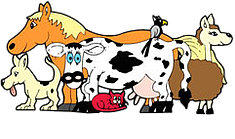Surgical Discharge Instructions
 Your dog has undergone a major operation. Smooth recovery will depend upon continued nursing at home. Your job in the recovery period at home is just as important as the procedure we have just completed.
Your dog has undergone a major operation. Smooth recovery will depend upon continued nursing at home. Your job in the recovery period at home is just as important as the procedure we have just completed.
This care at home mainly entails restriction of activity because your dog does not understand the significance of the recovery period. In a short period of time activity will return and confinement indoors by you is of the utmost importance! This entails:
- No jumping or running
- No stair climbing
- No playing with other pets
- No “rough-housing”
When your dog goes outside to toilet, it must be on a short lead and returned indoors immediately. If your dog is to be left alone, it must be confined in a cage or other small area. This strict confinement must be continued during the entire convalescent period. Excessive activity often leads to re-injury or serious complications that result in failure of surgical sutures or worse and may necessitate re-suturing. This means possible additional expense to you and added discomfort for your pet.
Observe the incision daily for signs of redness, swelling, discharge or excessive licking. The incision should look better each day. Please do not hesitate to call if you are at all concerned. We have available various sizes of protective collars to keep your dog from licking the incision. Licking usually leads to chewing out sutures, which can occur in a matter of minutes. Call us as soon as possible if this occurs because this can result in an infection that is difficult to treat and may require hospitalisation.
"Observe the incision daily for signs of redness, swelling, discharge or excessive licking. The incision should look better each day."
In general, your dog should improve gradually each day. If it suddenly worsens please call us as soon as possible. Our aim is to help your dog return to a normal and pain free life. Please call if you have any concerns.
© Copyright 2025 LifeLearn Inc. Used and/or modified with permission under license. This content written by LifeLearn Animal Health (LifeLearn Inc.) is licensed to this practice for the personal use of our clients. Any copying, printing or further distribution is prohibited without the express written consent of LifeLearn. This content does not contain all available information for any referenced medications and has not been reviewed by the FDA Center for Veterinary Medicine, or Health Canada Veterinary Drugs Directorate. This content may help answer commonly asked questions, but is not a substitute for medical advice, or a proper consultation and/or clinical examination of your pet by a veterinarian. Please contact your veterinarian if you have any questions or concerns about your pet’s health. Created on Jun 20, 2015.

